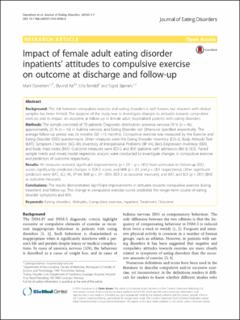| dc.contributor.author | Danielsen, Marit | |
| dc.contributor.author | Rø, Øyvind | |
| dc.contributor.author | Romild, Ulla Kristina | |
| dc.contributor.author | Bjørnelv, Sigrid | |
| dc.date.accessioned | 2020-04-20T07:34:37Z | |
| dc.date.available | 2020-04-20T07:34:37Z | |
| dc.date.created | 2017-01-13T11:25:59Z | |
| dc.date.issued | 2016 | |
| dc.identifier.citation | Journal of Eating Disorders. 2016, 4:7 (1), . | en_US |
| dc.identifier.issn | 2050-2974 | |
| dc.identifier.uri | https://hdl.handle.net/11250/2651606 | |
| dc.description.abstract | Background
The link between compulsive exercise and eating disorders is well known, but research with clinical samples has been limited. The purpose of the study was to investigate changes in attitudes towards compulsive exercise and its impact on outcome at follow-up in female adult hospitalised patients with eating disorders.
Methods
The sample consisted of 78 patients: Diagnostic distribution: anorexia nervosa 59 % (n = 46), approximately 22 % (n = 16) in bulimia nervosa, and Eating Disorder not Otherwise Specified respectively. The average follow-up period was 26 months (SD =15 months). Compulsive exercise was measured by the Exercise and Eating Disorder (EED) questionnaire. Other measures were the Eating Disorder Inventory (EDI-2), Body Attitude Test (BAT), Symptom Checklist (SCL-90), Inventory of Interpersonal Problems (IIP 64), Beck Depression Inventory (BDI), and body mass index (BMI). Outcome measures were EDI-2 and BMI (patients with admission BMI ≤ 18.5). Paired sample t-tests and mixed model regression analysis were conducted to investigate changes in compulsive exercise and predictors of outcome respectively.
Results
All measures revealed significant improvements (p < .01 – p < .001) from admission to follow-up. EED scores significantly predicted changes in EDI-2 scores and BMI (p < .01 and p < .001 respectively). Other significant predictors were BAT, SCL-90, IIP-64, BMI (p < .01–.001) (EDI-2 as outcome measure), and BAT and BDI (p < .001) (BMI as outcome measure).
Conclusions
The results demonstrated significant improvements in attitudes towards compulsive exercise during treatment and follow-up. The change in compulsive exercise scores predicted the longer-term course of eating disorder symptoms and BMI. | en_US |
| dc.language.iso | eng | en_US |
| dc.publisher | BioMed Central | en_US |
| dc.rights | Navngivelse 4.0 Internasjonal | * |
| dc.rights.uri | http://creativecommons.org/licenses/by/4.0/deed.no | * |
| dc.title | Impact of female adult eating disorder inpatients' attitudes to compulsive exercise on outcome at discharge and follow-up | en_US |
| dc.type | Peer reviewed | en_US |
| dc.type | Journal article | en_US |
| dc.description.version | publishedVersion | en_US |
| dc.source.pagenumber | 10 | en_US |
| dc.source.volume | 4:7 | en_US |
| dc.source.journal | Journal of Eating Disorders | en_US |
| dc.source.issue | 1 | en_US |
| dc.identifier.doi | 10.1186/s40337-016-0096-0 | |
| dc.identifier.cristin | 1426588 | |
| dc.description.localcode | Open Access This article is distributed under the terms of the Creative Commons Attribution 4.0 International License (http://creativecommons.org/licenses/by/4.0/), which permits unrestricted use, distribution, and reproduction in any medium, provided you give appropriate credit to the original author(s) and the source, provide a link to the Creative Commons license, and indicate if changes were made. The Creative Commons Public Domain Dedication waiver (http://creativecommons.org/publicdomain/zero/1.0/) applies to the data made available in this article, unless otherwise stated. | en_US |
| cristin.ispublished | true | |
| cristin.fulltext | original | |
| cristin.qualitycode | 1 | |

